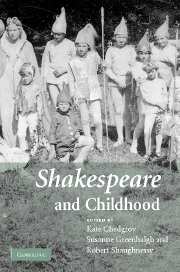Book contents
- Frontmatter
- Contents
- Acknowledgements
- Notes on contributors
- Note on the text
- 1 Introduction
- PART 1 SHAKESPEARE'S CHILDREN
- PART 2 CHILDREN'S SHAKESPEARES
- 8 Introduction: reinventing Shakespearean childhoods
- 9 Play's the thing: agency in children's Shakespeares
- 10 Shakespeare in the Victorian children's periodicals
- 11 Growing up with Shakespeare: the Terry family memoirs
- 12 Shakespeare in the company of boys
- 13 Dream children: staging and screening childhood in A Midsummer Night's Dream
- 14 Shakespeare (')tween media and markets in the 1990s and beyond
- APPENDICES
- Index
14 - Shakespeare (')tween media and markets in the 1990s and beyond
Published online by Cambridge University Press: 22 September 2009
- Frontmatter
- Contents
- Acknowledgements
- Notes on contributors
- Note on the text
- 1 Introduction
- PART 1 SHAKESPEARE'S CHILDREN
- PART 2 CHILDREN'S SHAKESPEARES
- 8 Introduction: reinventing Shakespearean childhoods
- 9 Play's the thing: agency in children's Shakespeares
- 10 Shakespeare in the Victorian children's periodicals
- 11 Growing up with Shakespeare: the Terry family memoirs
- 12 Shakespeare in the company of boys
- 13 Dream children: staging and screening childhood in A Midsummer Night's Dream
- 14 Shakespeare (')tween media and markets in the 1990s and beyond
- APPENDICES
- Index
Summary
The Shakespeare industry has recently achieved striking market penetration in the United States, the United Kingdom and elsewhere into ‘niche markets’ of earliest childhood, including, to name just a selection, videos such as Baby Shakespeare, which has a recitation of Oberon's ‘I know a bank where the wild thyme blows’; Fox Network and Disney animated cartoons and television situation comedies that cite or thematize Shakespeare; Shakespeare episodes of Public Broadcasting Service (PBS) puppet shows such as Between the Lions and animated cartoons such as Seven Little Monsters; ‘family’ films such as Dazzle (dir. David Lister,USA 1999), about a widower who meets a fairy and a teacher; and madefor-television film retellings of fairy tales starring adults such as Jim Henson's Jack and the Beanstock: The Real Story (dir. Brian Henson, USA 2001), with a mention of Romeo and Juliet and a shot of an old edition of Shakespeare's collected works in the giant's library; activity products such as pop-up books on Shakespeare's life; a Treasure Chest ‘book’ called Shakespeare complete with printing set and model Globe theatre; scattered references throughout Lemony Snicket's ten-volume A Series of Unfortunate Events; a Shakespeare action figure with detachable quill and book; plush Shakespeare beanie dolls; and even Mickey and Minnie Mouse and Barbie and Ken dolls dressed as Romeo and Juliet.
- Type
- Chapter
- Information
- Shakespeare and Childhood , pp. 218 - 232Publisher: Cambridge University PressPrint publication year: 2007



